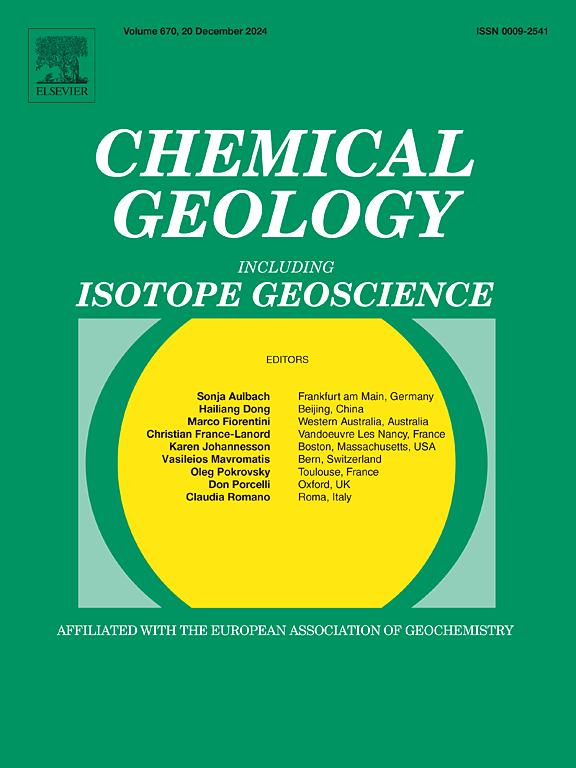Key role of recycled terrigenous sediments in generating continental arc magmatism in the West Qinling orogen, China
IF 3.6
2区 地球科学
Q1 GEOCHEMISTRY & GEOPHYSICS
引用次数: 0
Abstract
Substantial quantities of heterogeneous sediments are transported into the mantle at subduction zones. However, geochemical signatures linked to recycled terrigenous sediments are almost absent in MORB and are only sporadically observed in some hotspot volcanoes. Therefore, identifying the provenance of the subducting sediments and their fate in the mantle is critical for unraveling the geochemical evolution of the silicate earth. Here we present a comprehensive study of the Triassic ultramafic-mafic igneous rocks from the West Qinling orogen, China. These rocks display arc-like trace element features, weakly enriched Sr–Nd–Hf isotopes, low Ba/Th, Ba/La, Pb/Ce and U/Th ratios, and high Th/La, Th/Yb, Th/Nd and La/Sm ratios. These characteristics suggest that they originate from a mantle source predominantly metasomatized by the subducting sediment-derived hydrous melts. In addition, their high Th/La, Th/Yb and Hf/Sm ratios, paired with low Lu/Hf ratio and significantly low εHf(t) values, closely resemble those of terrigenous sediments, indicating a primarily terrigenous origin. Furthermore, these rocks exhibit lighter Li isotope ratios than MORB, similar to the arc rocks whose mantle sources have incorporated isotopically light terrigenous sediments. By comparing the geochemical features of these ultramafic-mafic igneous rocks with seafloor sediments, we propose the rocks in the West Qinling orogen are derived from a mantle wedge predominantly enriched by subducting terrigenous sediments. Their geochemical features are similar to those of modern continental arcs, suggesting the contribution of different sediment types largely depends on the location of the island arc (oceanic vs. continental). Moreover, much of the subducting sediments may rapidly return to the surface during continental arc magmatism. Therefore, this study provides new insights into the origin and fate of subducting terrigenous sediments in the mantle, as well as their role in generating mafic magmatism in continental arc systems.
西秦岭造山带陆源再循环沉积在大陆弧岩浆活动形成中的关键作用
大量的非均质沉积物在俯冲带被输送到地幔中。然而,与再循环陆源沉积物相关的地球化学特征在MORB中几乎不存在,仅在一些热点火山中零星观察到。因此,确定俯冲沉积物的来源及其在地幔中的命运对于揭示硅酸盐土的地球化学演化至关重要。本文对中国西秦岭造山带三叠纪超基性-基性火成岩进行了综合研究。岩石微量元素呈弧形,Sr-Nd-Hf同位素弱富集,Ba/Th、Ba/La、Pb/Ce和U/Th比值低,Th/La、Th/Yb、Th/Nd和La/Sm比值高。这些特征表明它们起源于一个主要由俯冲沉积衍生的含水熔体交代的地幔源。较高的Th/La、Th/Yb和Hf/Sm比值,较低的Lu/Hf比值和较低的εHf(t)值,与陆源沉积物非常相似,表明其主要为陆源沉积。此外,这些岩石的Li同位素比MORB轻,类似于地幔源中含有同位素较轻的陆源沉积物的弧岩。通过对比这些超镁铁质-基性岩浆岩与海底沉积物的地球化学特征,认为西秦岭造山带的岩石来源于以俯冲陆源沉积物为主的地幔楔体。它们的地球化学特征与现代大陆弧相似,表明不同沉积物类型的贡献在很大程度上取决于岛弧的位置(海洋与大陆)。此外,在大陆弧岩浆活动期间,许多俯冲沉积物可能迅速返回地表。因此,本研究对地幔俯冲陆源沉积物的起源、归宿及其在大陆弧体系中基性岩浆活动形成中的作用提供了新的认识。
本文章由计算机程序翻译,如有差异,请以英文原文为准。
求助全文
约1分钟内获得全文
求助全文
来源期刊

Chemical Geology
地学-地球化学与地球物理
CiteScore
7.20
自引率
10.30%
发文量
374
审稿时长
3.6 months
期刊介绍:
Chemical Geology is an international journal that publishes original research papers on isotopic and elemental geochemistry, geochronology and cosmochemistry.
The Journal focuses on chemical processes in igneous, metamorphic, and sedimentary petrology, low- and high-temperature aqueous solutions, biogeochemistry, the environment and cosmochemistry.
Papers that are field, experimentally, or computationally based are appropriate if they are of broad international interest. The Journal generally does not publish papers that are primarily of regional or local interest, or which are primarily focused on remediation and applied geochemistry.
The Journal also welcomes innovative papers dealing with significant analytical advances that are of wide interest in the community and extend significantly beyond the scope of what would be included in the methods section of a standard research paper.
 求助内容:
求助内容: 应助结果提醒方式:
应助结果提醒方式:


